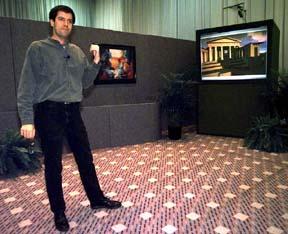![]()
Classifieds
Personals
Job listings
Model Homes
Place an ad
![]()
Editorials
Horoscope
Lottery
Weather
Death Notices
CyberSurvey
Search Engine
Back Issues
Site highlights
![]()
Accent
Autos
Business
Casino Guide
Comics
Cyberia
Discovery
Food
Golf Guide
Homefinder
Homestyle
Macomb
Mail from the net
Metro
Metro Center
MetroLife
Money
Movie Finder
Nation/World
Obituaries
Outlook
On Detroit
Rearview Mirror
Screens
Showtime
Sports
Sports: College
Sports: Preps
Sports: Lions
Sports: Pistons
Sports: Wings
Sports: Tigers
TV Listings
Voices
![]()
By e-mail
Post letters
to The News
Person-
to-person
Staff
addresses
By phone
Departments
and editors
Circulation
Home delivery
IBM unveils computer that sees and hears
Experimental device responds to commands, movement from people.
IBM researcher Mark Lucente demonstrates how the computer responds to gestures and vocal commands.By David E. Kalish / Associated Press
LAS VEGAS - IBM researcher Mark Lucente waves his hands in the air before the computer. Two colorful spirals on the screen float in the same direction.
"Let's see the world," he commands, and the view switches to a bright blue globe. "Make it this big," he says, drawing his hands together, and the globe grows smaller.
That's the future according to International Business Machines Corp., which showed off a computer that combines, albeit crudely, the ability to see and hear.
It's a future where machines obey people and act more like humans than faceless drones.
The company foresees versions in commercial use in about two years. For example, people walking by a storefront window could "ask" a mannequin to talk about products that are on sale. The mannequin would appear to follow the person's movements as it talks back.
"I want computers to be intelligent," Lucente said in a demonstration during this week's Comdex computer trade show in New York. "I think a good way to start is by giving them eyes and ears."
Beyond the practical applications, putting a more human face on computers could help polish IBM's image, dulled by years of selling clunky traditional computer equipment.
It's not the first time IBM has turned to technology for help.
Last May, the company's Deep Blue computer crushed the world's greatest chess player, Gerry Kasparov. The media rushed to adore the victorious boxes of IBM circuitry, and the company's stock price sailed skyward in response.
While the technologies are not new, IBM's novel idea was to mesh them in one machine costing between $20,000 and $30,000.
IBM used the company's existing ViaVoice speech recognition software to interpret spoken commands, which are picked up by a hidden microphone. A video camera above the computer screen sends information to a system that tracks movement and gestures.
As a result, when a person in front of the camera turns to one side, the image on the screen does also; when he or she moves further away, the image grows smaller to give more perspective.
Indeed, not all the technology is IBM's; the visual tracking software, for example, is used in factories to inspect parts.
The technology needs work. When a reporter waved his hands in front of the screen, the objects moved the wrong way because the camera was mistakenly tracking another reporter in the background.
"We're right at that magical moment when these technologies seem a little crazy but they're actually pretty accessible," Lucente said.
